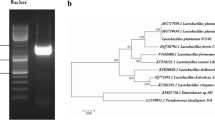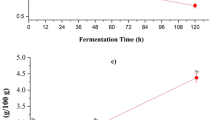Abstract
The objectives of this study were to analyze antioxidant activities and identify volatile compounds in mixed berry juice after fermentation by lactic acid bacteria (LAB). Antioxidant activity of the mixed berry juice increased significantly from 209.57±2.93 to 268.30±1.75 μmol TE/g after 24 h of fermentation. After LAB fermentation, 34 volatile compounds were identified. Among them, three compounds—benzoic acid, benzaldehyde, and vitispirane—showed significant changes in their concentrations. Peak areas of benzoic acid and benzaldehyde, which are known to possess antioxidant activities, increased by 64 and 188%, respectively, after fermentation. However, the peak area of vitispirane, which is the most abundant terpene compound in berry juices, decreased by 92% after fermentation.
Similar content being viewed by others
References
Park HM, Yang SJ, Kang J, Lee DH, Kim DI, Hong JH. Quality characteristics and granule manufacture of mulberry and blueberry fruit extracts. Korean J. Food Cook. Sci. 28: 375–382 (2012)
Dröge W. Free radicals in the physiological control of cell function. Physiol. Rev. 82: 47–95 (2002)
Park SH, Hwang HS, Han JH. Development of drink from composition with medicinal plants and evaluation of its physiological function. J. Nutr. Health 37: 364–372 (2004)
Rocha A, Wang L, Penichet M, Martins-Green M. Pomegranate juice and specific components inhibit cell and molecular processes critical for metastasis of breast cancer. Breast Cancer Res. Tr. 136: 647–658 (2012)
Castro L, Freeman BA. Reactive oxygen species in human health and disease. Nutrition 17: 161–165 (2001)
Peìrez-Jimeìnez J, Neveu V, Vos F, Scalbert A. Systematic analysis of the content of 502 polyphenols in 452 foods and beverages: an application of the phenol-explorer database. J. Agr. Food Chem. 58: 4959–4969 (2010)
Jang MH, Kim MD. ß-1,4-Xylosidase activity of Leuconostoc lactic acid bacteria isolated from kimchi. Korean J. Food Sci. Technol. 43: 169–175 (2011)
Kang J, Li Z, Wu T, Jensen GS, Schauss AG, Wu X. Anti-oxidant capacities of flavonoid compounds isolated from acai pulp (Euterpe oleracea Mart.). Food Chem. 122: 610–617 (2010)
Lindroth RL. Hydrolysis of phenolic glycosides by midgut ß-glucosidases in Papilio glaucus subspecies. Insect Biochem. 18: 789–792 (1988)
Kang OJ. Production of fermented tea with Rhodotorula yeast and comparison of its antioxidant effects to those of unfermented tea. Korean J. Food Cook. Sci. 26: 422–427 (2010)
Park SJ, Kim ES, Choi YS, Kim JD. Effects of sophorae fructus on antioxidative activities and lipid levels in rats. Prev. Nutr. Food Sci. 37: 1120–1125 (2008)
Suh J, Paek OJ, Kang Y, Ahn JE, Yun J, Oh K-S, An Y-S, Park S-H, Lee S-J. Study on theantioxidant activity in the various vegetables. J. Food Hyg. Safety 28: 337–341 (2013)
Balogh E, Hegedûs A, Stefanovits-Bányai É. Application of and correlation among antioxidant and antiradical assays for characterizing antioxidant capacity of berries. Sci. Hortic.-Amsterdam 125: 332–336 (2010)
Kim HY, Woo KS, Hwang IG, Lee YR, Jeong HS. Effects of heat treatments on the antioxidant activities of fruits and vegetables. Korean J. Food Sci. Technol. 40: 166–170 (2008)
Cho MJ, Howard LR, Prior RL, Clark JR. Flavonoid glycosides and antioxidant capacity of various blackberry, blueberry and red grape genotypes determined by highperformance liquid chromatography/mass spectrometry. J. Sci. Food Agr. 84: 1771–1782 (2004)
Zhu N, Sheng S, Li D, LaVoie E J, Karwe MV, Rosen RT, Ho CT. Antioxidative flavonoid glycosides from quinoa seeds (Chenopodium quinoa Willd). J. Food Lipids 8: 37–44 (2001)
Bokkenheuser VD, Shackleton C, Winter J. Hydrolysis of dietary flavonoid glycosides by strains of intestinal Bacteroides from humans. Biochem. J. 248: 953–956 (1987)
Ohara H, Owaki M, Sonomoto K. Xylooligosaccharide fermentation with Leuconostoc lactis. J. Biosci. Bioeng. 101: 415–420 (2006)
Yang HS, Choi YJ, Oh HH, Moon JS, Jung HK, Kim KJ, Choi BS, Lee JW, Huh CK. Antioxidative activity of mushroom water extracts fermented by lactic acid bacteria. Prev. Nutr. Food Sci. 43: 80–85 (2014)
Kraujalyte V, Leitner E, Venskutonis PR. Characterization of Aronia melanocarpa volatiles by headspace-solid-phase microextraction (HS-SPME), simultaneous distillation/extraction (SDE), and gas chromatographyolfactometry (GC-O) methods. J. Agr. Food Chem. 61: 4728–4736 (2013)
Belitz HD, Grosch W. Food Chemistry. 2nd ed. Springer, Heidelberg, Germany. pp. 806–861 (2004)
Lim SH, Nam H, Baek HH. Aroma characteristics of acai berry. Food Sci. Biotechnol. 48: 122–127 (2016)
Nile SH, Park SW. Edible berries: Bioactive components and their effect on human health. Nutrition 30: 134–144 (2014)
Hirvi T, Honkanen E, Pyysalo T. The aroma of cranberries. Eur. Food Res. Technol. 172: 365–367 (1981)
D’Agostino M, Sanz J, Sanz M, Giuffrè A, Sicari V, Soria AC. Optimization of a solid-phase microextraction method for the gas chromatography–mass spectrometry analysis of blackberry (Rubus ulmifolius Schott) fruit volatiles. Food Chem. 178: 10–17 (2015)
Park JB, Sim HS, Ha SJ, Kim MD. Enhancement of antioxidative activities of berry or vegetable juices through fermentation by lactic acid bacteria. Microbiol. Biotechnol. Lett. 43: 291–295 (2015)
Lee S, Kim JK. Quality characteristics of Aronia melanocarpa by different drying method. Korean J. Food Preserv. 22: 56–62 (2015)
Ungvari Z, Ridgway I, Philipp EE, Campbell CM, McQuary P, Chow T, Coelho M, Didier ES, Gelino S, Holmbeck MA. Extreme longevity is associated with increased resistance to oxidative stress in Arctica islandica, the longest-living non-colonial animal. J. Gerontol. A Biol. Sci. Med. Sci. 66: 741–750 (2011)
Arthur CL, Pawliszyn J. Solid phase microextraction with thermal desorption using fused silica optical fibers. Anal. Chem. 62: 2145–2148 (1990)
Zhang Z, Yang MJ, Pawliszyn J. Solid-phase microextraction. A solvent-free alternative for sample preparation. Anal. Chem. 66: 844A–853A (1994)
Tiitinen K, Hakala M, Kallio H. Headspace volatiles from frozen berries of sea buckthorn (Hippophae rhamnoides L.) varieties. Eur. Food Res. Technol. 223: 455–460 (2006)
Harter HL. Critical values for Duncan’s new multiple range test. Biometrics 671–685 (1960)
Sieber R, Bütikofer U, Bosset J. Benzoic acid as a natural compound in cultured dairy products and cheese. Int. Dairy J. 5: 227–246 (1995)
Velika B, Kron I. Antioxidant properties of benzoic acid derivatives against superoxide radical. Free Radical. Antioxid. 2: 62–67 (2012)
Ullah I, Khan AL, Ali L, Khan AR, Waqas M, Hussain J, Lee IJ, Shin JH. Benzaldehyde as an insecticidal, antimicrobial, and antioxidant compound produced by Photorhabdus temperata M1021. J. Microbiol. 53: 127–133 (2015)
Ferreira ACS, de Pinho PG. Nor-isoprenoids profile during port wine ageinginfluence of some technological parameters. Anal. Chim. Acta 513: 169–176 (2004)
Panda SK, Behera SK, Qaku XW, Sekar S, Ndinteh DT, Nanjundaswamy H, Ray RC, Kayitesi E. Quality enhancement of prickly pears (Opuntia sp.) juice through probiotic fermentation using Lactobacillus fermentum-ATCC 9338. LWT-Food Sci. Technol. 75: 453–459 (2017)
Author information
Authors and Affiliations
Corresponding author
Rights and permissions
About this article
Cite this article
Park, JB., Lim, SH., Sim, HS. et al. Changes in antioxidant activities and volatile compounds of mixed berry juice through fermentation by lactic acid bacteria. Food Sci Biotechnol 26, 441–446 (2017). https://doi.org/10.1007/s10068-017-0060-z
Received:
Revised:
Accepted:
Published:
Issue Date:
DOI: https://doi.org/10.1007/s10068-017-0060-z




